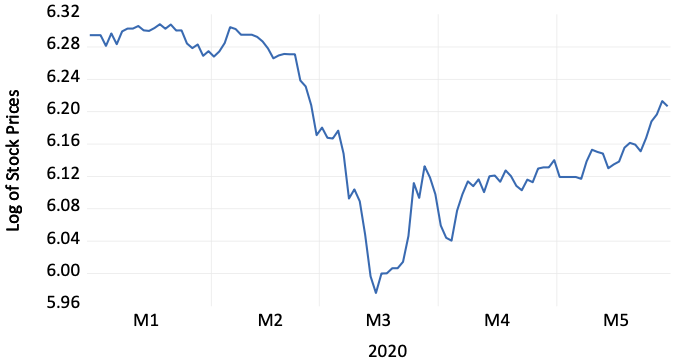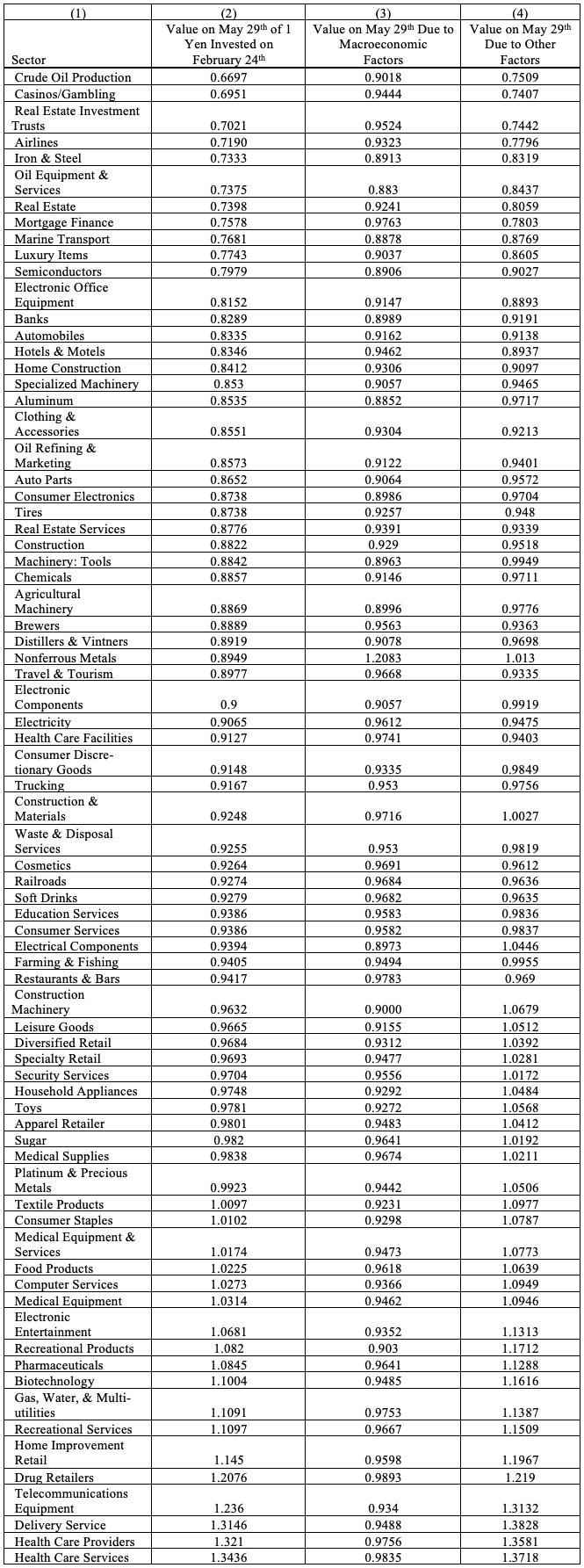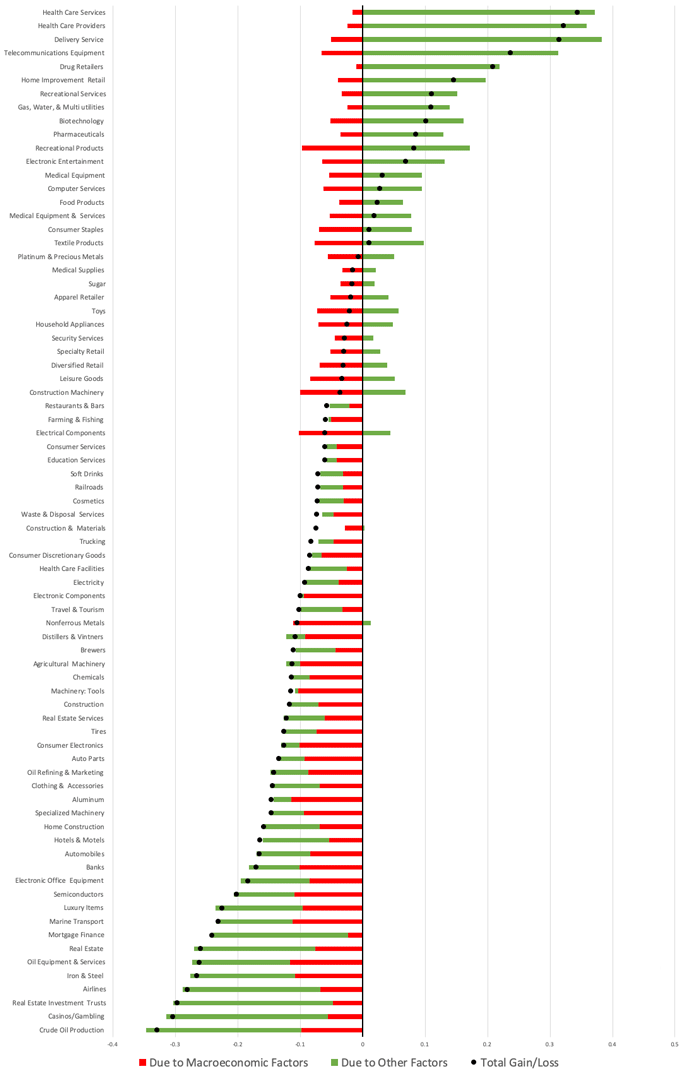Introduction
Japan has taken several steps to limit the spread of COVID-19. In March Prime Minister Abe requested that Japanese schools close. In April, the Japanese government imposed a voluntary lockdown. This included asking people to work from home, requesting that non-essential businesses close, and demanding that crowds not assemble at ballgames and other large events. The government also imposed restrictions on travel from abroad. By the end of May the government lifted the state of emergency and eased some of the restrictions. How are the pandemic and the government's attempts to control it affecting Japanese businesses?
One way to investigate this is to examine how Japanese stock prices have responded. In theory stock prices equal the expected present value of future cash flows. They thus shed light on how investors believe companies will be affected. Stock prices are also forward-looking, implying that they provide information about how market participants expect companies to fare in the future.
Aggregate Stock Prices in Japan
Figure 1 plots stock prices for the entire Japanese stock market from 1 January 2020 until 29 May 2020. It shows that prices fell about 30 percent between 24 February and 16 March. Prices have since rebounded and at the end of May were down about 6 percent relative to their value on 24 February.
Examining Japanese Sectoral Stock Returns
To see how individual sectors have performed, daily returns on each sector can be compounded from the beginning of the Japanese stock market fall on 24 February 2020 until the end of May 2020. Returns can also be decomposed into the portion due to macroeconomic variables and the portion due to sector-specific factors. This decomposition sheds light on whether sectoral differences in performance are driven by the macroeconomic environment (e.g., the slowdown in the world economy) or by idiosyncratic factors affecting individual sectors (e.g., travel restrictions).
A regression equation is used to estimate how macroeconomic variables affect returns. Daily stock returns for Japanese sectors are regressed on 1) daily returns for the overall Japanese stock market, 2) daily returns on the world stock market, 3) the daily percentage change in the yen/dollar exchange rate, and 4) the daily percentage change in the dollar spot price of Dubai crude oil. These data come from the Datastream database. The sample period extends from 1 January 1993 to 29 May 2020.
This framework is what economists call a four-factor model for stock returns. The four right-hand side variables capture the effects of conditions in the Japanese economy, conditions in the world economy, exchange rates, and oil prices on stock returns. The portion of returns not explained by these four macroeconomic variables (the residuals) then captures sector-specific responses.
Results
Table 1 presents the findings for Japanese sectors. A value less than one implies that one yen invested on 24 February had lost value by 29 May and a value greater than one implied it had gained value. Column (2) presents the results for the overall stock return in a sector, column (3) for the portion of the return driven by macroeconomic factors, and column (4) for the portion driven by idiosyncratic factors (Note 1). The rows of the table are ordered from the sector that performed worst during this period to the sector that performed best.
Sectors related to real estate have suffered. The value for real estate investment trusts (REITs) in column (2) is 0.7021, the value for mortgage finance is 0.7578, the value for real estate is 0.7398, and the value for home construction is 0.8412. To understand these numbers, the value of 0.7021 for REITs indicates that 1 yen invested in real estate investment trusts on 24 February 2020 would be worth only 0.7021 yen on 29 May 2020. Examining columns (3) and (4) indicates that real estate has suffered not primarily because of the macroeconomic environment but rather because of other factors. The state of emergency in particular has interfered with real estate transactions.
Sectors related to travel and leisure have also been damaged. The value for casinos and gambling in column (2) is 0.6951, the value for airlines in 0.7190, the value for hotels & motels is 0.8346, and the value for travel & tourism is 0.8977. Column (3) indicates that these losses are not driven primarily by macroeconomic factors. Rather they reflect restrictions on travel that have plagued the industry.
The oil sector has also performed poorly. The return to one yen invested in crude oil production is 0.6697 and the return to one yen invested in oil equipment & services is 0.7375. Columns (3) and (4) indicate that while macroeconomic factors such as low oil prices have contributed to these losses, more of the contribution has come from other factors. Lockdowns and travel bans have caused demand for oil to collapse and decimated the industry.
The automobile sector and related industries have also been hit. The value for automobiles in column (2) is 0.8335, for automobile parts 0.8652, for iron & steel 0.7333, and for tires 0.8738. For automobiles both the macroeconomic variables and other factors have contributed equally to the losses. On the macroeconomic front exports have collapsed. On the sector-specific front many dealers remained shut during the emergency.
The electronic office equipment sector has lagged. Its value in column (2) is 0.8152. This reflects the fact that many offices have been closed.
The machinery sector has also suffered losses. One yen invested in specialized machinery stocks would be worth 0.853, one yen invested in tool stocks would be worth 0.8842, and one yen invested in agricultural machinery would be worth 0.8869. Columns (3) and (4) indicate that these losses were driven by macroeconomic factors. The slowdowns in Japan and the rest of the world have frozen demand for machinery.
On the other hand, sectors related to peoples' health have done well. The value in column (2) for pharmaceuticals is 1.0845, the value for biotechnology is 1.1004, the value for drug retailers is 1.2076, the value for health care providers is 1.321, and the value for health care services is 1.3436. Columns (3) and (4) indicate that these gains are not driven by macroeconomic variables but entirely by idiosyncratic factors. The COVID-19 Crisis has been a boon for health-related industries.
Businesses that provide entertainment and distractions at home have also gained. The value in column (2) for telecommunications equipment (including smartphones) is 1.236, the value for recreational services is 1.1097, the value for recreational products is 1.082, and the value for electronic entertainment is 1.0681. These gains are not driven by macroeconomic variables but entirely by other factors. As people have huddled at home, their demand for entertainment products has soared.
Delivery services have also benefitted. Its value in column (2) is 1.3146. Again, these gains were not driven at all by macroeconomic factors. Delivery services have provided a critical lifeline for those forced to stay at home.
Conclusion
This column has investigated how Japanese sectoral stock returns have performed during the Coronavirus Pandemic. It has also investigated whether these responses were driven by macroeconomic or by sector-specific factors. The Japanese machinery sector was harmed by the macroeconomic environment, as the slowdown froze demand for capital goods. The real estate and travel & leisure sectors were harmed by specific influences such as the effects of the voluntary lockdown and travel restrictions on these industries. Electronic office equipment and automobiles have been hit by both the macroeconomic environment (e.g., the slowing world economy) and by idiosyncratic factors (e.g., the closing of auto dealerships). On the other hand, sectors related to peoples' health and their ability to obtain entertainment and goods and services at home have done well. Their gains have been driven entirely by sectoral advantages and not by macroeconomic changes. These findings may provide information for policymakers as they seek to promote recovery from this devastating crisis.



[ Click to enlarge ]


